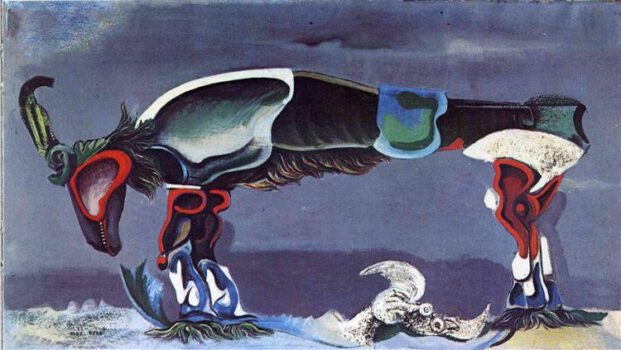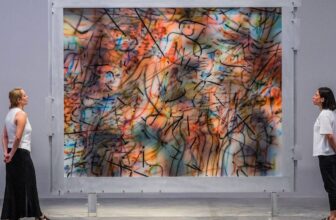What Was Max Ernst Known For
Max Ernst (born in Brühl, Germany in 1891; died Paris, 1976) was a visionary German painter, sculptor, and printmaker, one of Dada’s provocateurs and a founding figure of Surrealism. Initially drawn to philosophy and psychology at university, Ernst abandoned formal studies after experiencing the horrors of World War I. The trauma transformed him into a radical critic of rationalism and bourgeois society, leading him to Dada in Cologne and later Surrealism in Paris alongside André Breton, Pablo Picasso, Joan Miró, and Paul Éluard .
He became famous for pioneering several groundbreaking techniques of automatism, painting driven by the subconscious, and for inventing distinctive methods like frottage, grattage, decalcomania, and oscillation (a primitive form of drip painting) . Ernst described his artistic mission as capturing “soft earthquakes”, subtle shifts in perception that unsettled accepted realities . His imagery frequently conjured dreamlike forests, hybrid creatures, symbolic birds, and eerie landscapes grounded in unconscious logic and mythology.
In 1954, he was awarded the Grand Prize for Painting at the Venice Biennale, and in 1959 received the Grand Prix National des Arts by the Paris Museum of Modern Art .
Max Ernst’s Famous Paintings
1. The Elephant Celebes (1921)
An early surrealist masterpiece, a sinister mechanical elephant standing in a barren landscape, juxtaposed with human forms and flying fish. It epitomizes Ernst’s Dada‑Surreal blend and is housed at Tate Modern in London.
2. The Wood (1927)
This eerie forest scene showcases Ernst’s signature grattage: scraping layers of paint to reveal textures and patterns. It resides in the National Museum Cardiff.
3. The Eye of Silence (L’œil du silence, 1943–44)
Created using decalcomania, Ernst pressed paint into and then peeled it from surfaces to create abstract formations which he then refined into surreal organic forms. The painting hangs in the Mildred Lane Kemper Art Museum in St. Louis.
4. Pietà or Revolution by Night (1923)
A provocative subversion of the classical pietà: Ernst cast his father as Mary and himself as Christ, set in a bleak, dreamlike stage. It’s held at the Tate Gallery, London .
5. Aquis Submersus (1919)
One of his earliest works hinting at Surrealism, floating clock, upside‑down figure in a pool, located at the Städel Museum in Frankfurt.
Other notable works include Here Everything Is Still Floating (1920), Men Shall Know Nothing of This (1923), Europe After the Rain, The Woman with 100 Heads (1929), A Week of Kindness series (1934), and many more panoramic surreal visions .
How Much Do Max Ernst Paintings Cost?
Auction records illustrate Ernst’s significant market value:
Leonora in the Morning Light (1940) sold at Sotheby’s in 2012 for about £4.3 million (~$7 million).
The Phases of the Night (1946) fetched around £4.3 million (~$5.5 million) at Christie’s New York in 2017 .
Smaller works or lesser-known pieces often appear at mid six‑figure to seven‑figure ranges depending on size, provenance, and technique.
While premium works reach multi‑million dollars, smaller panel or paper works can still fetch hundreds of thousands to over a million. Prices reflect technique, condition, rarity, and auction house reputation.
Artistic Techniques & Materials
Frottage
Originally applied on paper, later adapted to canvas: Ernst rubbed pencil or crayon over surfaces with textures, wood, leaves, metal, to transfer unexpected patterns. These become starting points for painting .
Grattage
Paint layers were applied, then the canvas placed over objects like metal or wood and scraped with blades or spatulas. This revealed hidden textures and guided surreal forms (e.g. The Wood) .
Decalcomania
Ernst applied thin paint layers, then pressed glass or paper onto them and pulled apart, creating tangled, organic textures. He selectively developed these into uncanny landscapes (Eye of Silence, Europe After the Rain) .
Oscillation (Dripping)
Suspending a paint container over canvas and letting it drip in pendulum motion – a precursor to Pollock’s action painting. Ernst experimented with it in the U.S. in the 1940s .
Collage & Photomontage
From early Dada years, Ernst cut images from 19th‑century prints, catalogs, textbooks, and recombined them into startling, dreamlike collages. Iconic collage‑novels include La femme 100 têtes (1929), A Week of Kindness (1934) .
Printmaking & Sculpture
He also created etchings, lithographs, screen prints, and sculptures using found materials, egg cartons, shells, flower pots, to build assemblage creatures and figures like Loplop, his bird‑alter‑ego .
Materials: Oil paint, canvas, wood panels, paper, glue, glass or paper for prints, metal, natural objects, and found items.
How Many Paintings Did He Make?
Exact numbers are difficult to pin down. Ernst’s output spanned six decades and included:
Hundreds of paintings (oil on canvas & panel)
Several graphic cycles, prints, and illustrated books
Collage‑novels and photomontage portfolios
Sculptures and assemblages
The Menil Collection alone contains over 104 works spanning 1920–1968 . His retrospective at MoMA featured around 180 works in one period alone . Altogether, he likely produced several hundred oil paintings, dozens of collage novellas, and hundreds of prints and drawings.
Where Can You See His Paintings Today?
Max Ernst’s works are held in major public collections worldwide:
Tate Modern, London: The Elephant Celebes, Pietà or Revolution by Night.
National Museum Cardiff, Wales: The Wood .
Mildred Lane Kemper Art Museum (Washington University, St. Louis): The Eye of Silence .
Städel Museum, Frankfurt: Aquis Submersus .
Additional works, and large holdings, are in the Menil Collection (Houston), MoMA, Albertina (Vienna), and the Max Ernst Museum in Brühl, Germany.
In Madrid, Bilbao’s Museo de Bellas Artes hosted a major showing of 54 Ernst works from a private collection, including Les mains aux oiseaux (1925) and Deux jeunes filles en de belles poses (1924), on display through 30 June 2025 before joining Bilbao’s permanent collection. Madrid’s Círculo de Bellas Artes also hosted a centennial exhibition tracing his connections with cinema and immersive techniques .
A Journey Through Ernst’s Mind
Imagine visiting an early Ernst painting, Aquis Submersus, in Frankfurt. You stare at the unreal scene: a diver-like figure floating beneath a clock‑moon, buildings cast strange reflections. You sense dislocation, this is not reality. It’s the world as seen through Ernst’s war-shocked subconscious.
Walk on to The Elephant Celebes in London. There, you meet the metallic elephant: totemic, mechanical, absurd. Here, Dada meets Surrealism. The work distorts logic, forcing you to question authority, just as Ernst questioned the post‑war world.
Continue to Cardiff where The Wood looms. Thick forest, carved safety rails, scraped paint textures, each bark‑like stroke hints at accident and discovery. You realize: Einstein never sought perfection. He sought the hidden forms emerging when paint surrenders to texture.
In St. Louis, The Eye of Silence glimmers. Blobs of ink pressed away became cavernous landscapes, enigmatic, silent, and teeming with life. Ernst’s decalcomania births structures that could be coral, rock, or monster, an automatism made visible in oil.
Throughout his life, Ernst constantly reinvented himself. From cut-and‑paste Dada collages to sophisticated prints and sculptures; from Cologne to Paris, exile in the US, and return to Europe, his journey was one of perpetual discovery .
Summary
| Topic | Key Details |
|---|---|
| Known For | Dada & Surrealism; inventing automatism techniques (frottage, grattage, decalcomania, oscillation); radical collage and dreamlike landscapes. |
| Famous Works | The Elephant Celebes, The Wood, The Eye of Silence, Pietà or Revolution by Night, Aquis Submersus, others. |
| Techniques & Materials | Frottage (rubbed textures), Grattage (scraped layers), Decalcomania (pressed paint), Oscillation (drip painting), collage, printmaking, sculptures with found objects. |
| Estimated Count | Several hundred oil paintings; dozens of collages; extensive print/graphic production; sculptural assemblages. |
| Auction Prices | Multi‑million USD/GBP for major works; e.g. |
| Where to See Them | Tate (London), National Museum Cardiff, Kemper Art Museum (St. Louis), Städel (Frankfurt), Menil Collection (Houston), Max Ernst Museum (Brühl), Bilbao, Madrid exhibitions. |
Max Ernst’s canvases appear as dreams made tangible, forested visions, mechanistic beasts, ghostly figures, symbols whispered from the subconscious. His methods reframed painting not as deliberate artistry, but as a collaboration with accident and the unconscious mind.
Ernst left behind not just canvases but a legacy of invention: frottage that lets chance speak, grattage that reveals buried forms, decalcomania that births alien terrain, and oscillation that drips time itself. His oeuvre, spanning painting, collage, print, sculpture, remains a vital wellspring for artists exploring texture, imagery, chance, and fantasy.
Whether viewed up close among the galleries of Europe, or through auction catalogues that record their staggering prices, Ernst’s works continue to challenge, disorient, and enchant. He remains a titan of 20th‑century art: a poet of the irrational, a magician of technique, and above all, a pioneer of visual imagination. image/ wikiart




